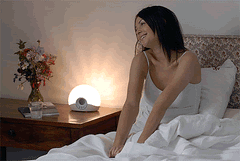Dawn Simlulators
Circadian Rhythm Phase Advance with Dawn Simulation Treatment for Winter Depression
Michael Terman Department of Psychiatry, Columbia University and New York State Psychiatric Institute, New York, NY, mt12@columbia.edu
Jiuan Su Terma Department of Psychiatry, Columbia University and New York State Psychiatric Institute, New York, NY
A naturalistic pattern of dawn simulation (93 min, 0.001-250 lux) delivered to sleeping patients with winter depression has clinical efficacy similar to postawakening bright light therapy. The authors tested the circadian phase-shifting capacity of the dawn signal in a placebo-controlled, randomized 3-week field trial using 4 photic or nonphotic comparators: 30-min, 10,000-lux bright light therapy; a 13-min, 250-lux light pulse at the end of sleep; and high- and low-density negative air ionization timed to match the dawn. Bright light and dawn treatments both produced average phase advances of ~30 min, while the pulse and ion exposure had minimal effect. The authors conclude that very dim, incremental levels of light at the end of the night, with a dominant red component through eyelid filtering, facilitate circadian rhythm phase advances, possibly in conjunction with room light after awakening.















